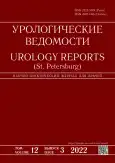Ambulatory uroflowmetric monitoring: recommendations for implementation in clinical practice
- Authors: Shaderkin I.A.1, Shaderkina V.A.2
-
Affiliations:
- I.M. Sechenov First Moscow State Medical University (Sechenov University)
- Urological information portal UroWeb.ru
- Issue: Vol 12, No 3 (2022)
- Pages: 203-210
- Section: Original articles
- URL: https://journals.rcsi.science/uroved/article/view/110873
- DOI: https://doi.org/10.17816/uroved110873
- ID: 110873
Cite item
Abstract
BACKGROUND: Urodynamic examination is recommended for patients with urinary disorders. In some categories of patients, it can be replaced by performing uroflowmetry in the patient’s usual home environment.
AIM: development of recommendations for health care managers and urologists on the introduction of ambulatory uroflowmetric monitoring and its use in everyday clinical practice.
MATERIALS AND METHODS: On the basis of the e-health laboratory of the Institute of Digital Medicine of the First Moscow State Medical University named after I.M. Sechenov, the Ministry of Health of Russia (Sechenov University) developed a unique method of home monitoring of uroflowmetry in male patients with symptoms of impaired urination using the wireless portable uroflowmeter “Flowselfi” developed in the Russian Federation. Based on experience, recommendations have been developed for the implementation of this method in clinical practice.
RESULTS: Equipment for home uroflowmetry should be reliable, simple, intuitive, affordable, portable, and able to wirelessly communicate with a patient’s smartphone or tablet for data accumulation and subsequent transmission to a doctor for processing the results. The patient should have preserved cognitive functions and be motivated to perform uroflowmetry, understand its importance in further treatment. The article provides typical instructions for patients and urologists using ambulatory uroflowmetry at home.
CONCLUSIONS: Ambulatory uroflowmetric monitoring (home uroflowmetry, outpatient home uroflowmetry) is a promising method of remote monitoring of patients requiring urination monitoring, including neurogenic and non-neurogenic urination disorders.
Full Text
##article.viewOnOriginalSite##About the authors
Igor A. Shaderkin
I.M. Sechenov First Moscow State Medical University (Sechenov University)
Email: info@uroweb.ru
ORCID iD: 0000-0001-8669-2674
SPIN-code: 3840-1697
Cand. Sci. (Med.), Head of the Laboratory of Electronic Health, Institute of Digital Medicine
Russian Federation, 1/2, Abrikosovskiy lane, Moscow, 19435Viktoriya A. Shaderkina
Urological information portal UroWeb.ru
Author for correspondence.
Email: viktoriashade@uroweb.ru
ORCID iD: 0000-0002-8940-4129
SPIN-code: 4941-5888
Scientific editor of the Urological information portal UroWeb.ru
Russian Federation, MoscowReferences
- Speakman M, Kirby R, Doyle S, Ioannou Ch. Burden of male lower urinary tract symptoms (LUTS) suggestive of benign prostatic hyperplasia (BPH) — focus on the UK. BJU Int 2015;115(4):508–519. doi: 10.1111/bju.12745
- Apolihin OI, Sivkov AV, Zolotuhin OV, et al. Prevalence of lower urinary tractsymptoms in men according to the results of population research. Experimental and Сlinical Urology. 2018(1):4–12. (In Russ.) doi: 10.29188/2222-8543-2018-9-1-4-12
- Brown ET, Krlin RM, Winters JC. Urodynamics: examining the current role of USD testing. What is the role of urodynamic testing in light of recent AUA urodynamics and overactive bladder guidelines and VALUE study? Curr Urol Rep. 2013;14(5):403–408. doi: 10.1007/s11934-013-0361-6
- Shaderkin IA, Lebedev GS, Vladzymyrskyy AV, et al. Information technologies for disabled patients’ home care. The Journal of Telemedicine and e-Health. 2018;(3(8)):57–63. (In Russ.) doi: 10.29188/2542-2413-2018-4-3-57-63
- Shaderkin IA, Lebedev GS, Shaderkina VA, et al. Outpatient urodynamic monitoring in patients with BPH: world and Russian experience. Urologiia. 2021(6):152–159. (In Russ.) doi: 10.18565/urology.2021.6.152-159
- Kvyatkovskii AE, Kvyatkovskii EA, Kvyatkovskaya TA. The first experience of the ukrainian uroflowmeter “flow-km” application for home uroflowmetryc monitoring. Urologiya. 2017;21(3(82)):9–15.
- Semenov BV, Byrko IA, Byrko NV, Kaidalova EA. Kriterii diagnostiki grupp riska u muzhchin starshe 40 let s ispol’zovaniem domashnego monitoringa urofloumetrii. Medical Scientific Bulletin of Central Chernozemye. 2008(34):133–142. (In Russ.)
- Kuzmenko VV, Kuzmenko AV, Gyaurgiev TA, et al. Nash opyt primeneniya domashnego monitoringa urofloumetrii u muzhchin s simptomami nizhnikh mochevykh putei. Tendentsii Razvitiya Nauki i Obrazovaniya. 2021(73–2):37–40. (In Russ.) doi: 10.18411/lj-05-2021-51
- Apolihin OI, Shadjorkin IA, Perhov VI, et al. Scientific background of telemedicine-based approaches for medical care organization in urology. Urologicheskie vedomosti. 2017;7(3):14–21. (In Russ.) doi: 10.17816/uroved7314-21
- Shaderkin IA, Vladzymyrskyy AV, Tsoy AA, et al. Diagnostic value of the portable urine analyzer “ETTA AMP-01” as a tool for self-monitoring in mHealth and screening in primary care. Experimental and Clinical Urology. 2015(4):22–26. (In Russ.)
- Shaderkin IA, Shaderkina VA. Remote health monitoring: motivating patients. Journal of Telemedicine and E-Health. 2020;6(3): 37–43. (In Russ.) doi: 10.29188/2542-2413-2020-6-3-37-43
- Lebedev GS, Fartushnyy EN, Shaderkin IA, et al. Bilding of the medical decision support system on the basis of providing medicine based on evidence-based medicine. Journal of Telemedicine and E-Health. 2019;5(1–2):8–16. (In Russ.) doi: 10.29188/2542-2413-2019-5-1-8-16
- Lebedev GS, Fomina IV, Shaderkin IA, et al. Main directions of development of Internet technologies in healthcare (systematic review). Social Aspects of Public Health. 2017;57(5):1–10. (In Russ.) doi: 10.21045/2071-5021-2017-57-5-10
- Danilov VV, Danilov VV, Ostobunaev VV, et al. Can the diagnosis be established on the basis of a single urine stream recording? Pacific Medical Journal. 2016;63(1):82–85. (In Russ.)
- Danilov VV, Osinkin KS, Danilov VV. Uroflowmetry monitoring in the assessment of urinary disorders of patients with benign prostatic hyperplasia. International Journal of Medicine and Psychology. 2019;2(4):112–117. (In Russ.)
- Pushkar DYu, Kasyan GR. Ambulatornyi urodinamicheskii monitoring. In: Funktsional’naya urologiya i urodinamika. Moscow: GHEOTAR-Media; 2014. P. 119–126. (In Russ.)
- Danilov VV, Osinkin KS, Sevriukov FA. Reproducibility of uroflowmetry results in patients with benign prostatic hyperplasia. Urology and Andrology. 2019;7(3):5–9. (In Russ.) doi: 10.20953/2307-6631-2019-3-5-9
Supplementary files







